Scripts
The Palaeohispanic languages were written both in semisyllabic scripts created in the Iberian Peninsula itself, and in colonial scripts, such as Ionic Greek or Latin.
|
Languages |
Scripts |
||||
|
|
Latin |
Greek |
North-Eastern or Levantine Iberian |
Southern Iberianl |
South-Western script |
|
Iberian |
X |
|
|||
|
Celtiberian |
X |
|
|
|
|
|
Lusitanian |
X |
|
|
|
|
|
Southern languages |
|
|
|
X |
|
|
South-Western language |
|
|
|
|
|
Scripts:
- North-Eastern or Levantine Iberian script
- Southern Iberian script
- Celtiberian script
- South-Western script
- Graeco-Iberian script
- Latin alphabet.
North-Eastern or Levantine Iberian Script
(Interactive table):
The variants of the signs that Untermann recognizes in his MLH III (1) p. 246-247 will pop up when hovering over the signs. It must be taken into account that bo1 and bo3 correspond respectively to ta2 and ta3, at least when the script is dual (Ferrer i Jané 2005, p. 960).
Figure 1: North-Eastern non-dual script. Writing direction: usually left-to-right. Source: Adapted from Ferrer-Moncunill 2019, p. 81 (Palaeohispanic Languages and Epigraphies).
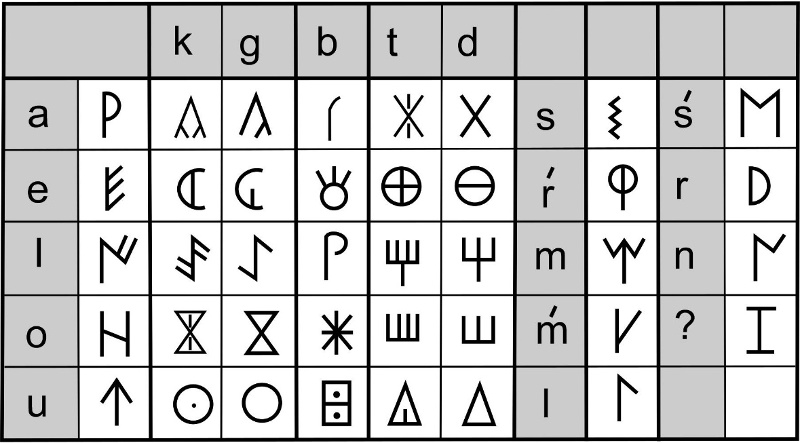
Figure 2: North-Eastern standard dual. Writing direction: usually left-to-right. Source: Adapted from Ferrer-Moncunill 2019, p. 81 (Palaeohispanic Languages and Epigraphies).
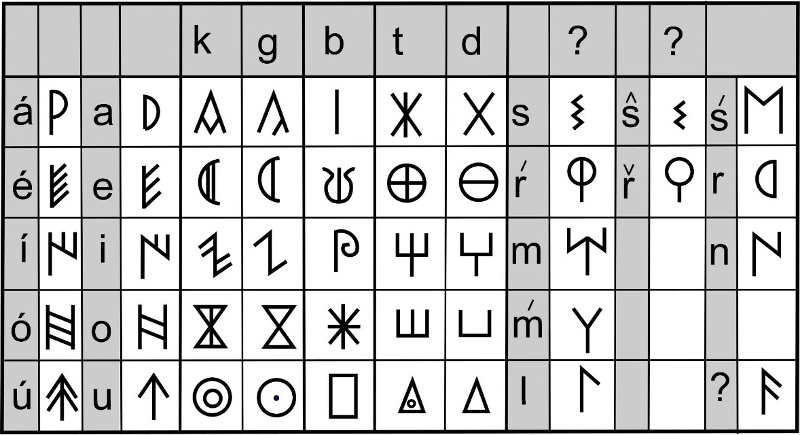
Figure 3: North-Eastern standard Dual. Writing direction: usually left-to-right. Source: Adapted from Ferrer-Moncunill 2019, p. 81 (Palaeohispanic Languages and Epigraphies). The extended variants have not been reported in the BDHesperia transcription.
Celtiberian script
(interactive table):
The variants of the signs that Untermann recognizes in his MLH IV p. 171 will pop up when hovering over the signs. It must be taken into account that bo1 corresponds to ta2, at least when the script is dual (Ferrer i Jané 2005, p. 960).
Figure 4: Celtiberian non-dual script. Writing direction: usually left-to-right. Source: Adapted from Ferrer-Moncunill 2019, p. 81 (Palaeohispanic Languages and Epigraphies).

Figure 5: Celtiberian dual script. Writing direction: usually left-to-right. Source: Adapted from Ferrer-Moncunill 2019, p. 81 (Palaeohispanic Languages and Epigraphies).
Southern Iberian Script
(Interactive table):
The palaeographic variants that J. de Hoz, Historia lingüística de la Península Ibérica en la Antigüedad II, p. 741 distinguishes will appear when hovering over the signs.
Figure 6: Southern non-dual script, with the classical attribution of the values for bo and bu. In black, accepted value signs. In red, those of disputed value. Writing direction: usually right-to-left. Source: Adapted from Ferrer-Moncunill 2019, p. 81 (Palaeohispanic Languages and Epigraphies).

Figure 7: Southern dual script: includes both the South-Eastern Iberian script and the Turdetan script. In black, accepted value signs. In red, those of disputed value. Writing direction: usually right-to-left. For some researchers, this script might not be dual. Source: Adapted from Ferrer-Moncunill 2019, p. 81 (Palaeohispanic Languages and Epigraphies).
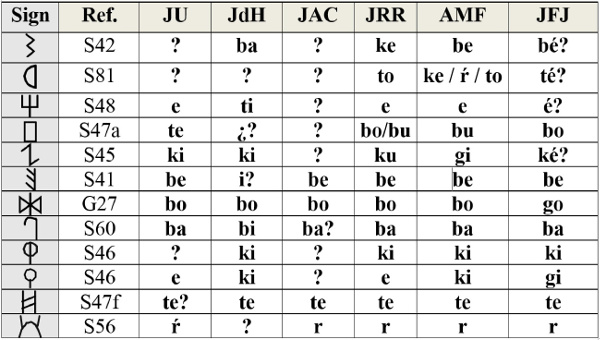
Figure 8: South-Eastern Iberian writing signs of disputed value. Source: Ferrer-Moncunill 2019, p. 95 (Palaeohispanic Languages and Epigraphies). Abbreviations: JU - Jürgen Untermann, JdH - Javier de Hoz, JAC - José Antonio Correa, JRR - Jesús Rodríguez Ramos, AMF – António Marques de Faria, JFJ - Joan Ferrer i Jané.
South-Western Script
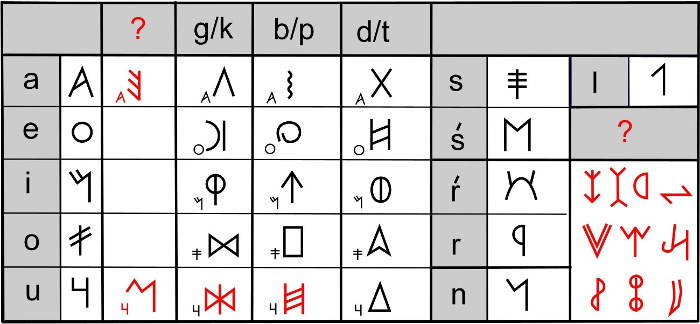
Figure 9: South-Western script. In black, accepted value signs. In red, those of disputed value. Writing direction: usually right-to-left. Source: Adapted from Ferrer-Moncunill 2019, p. 81 (Palaeohispanic Languages and Epigraphies).
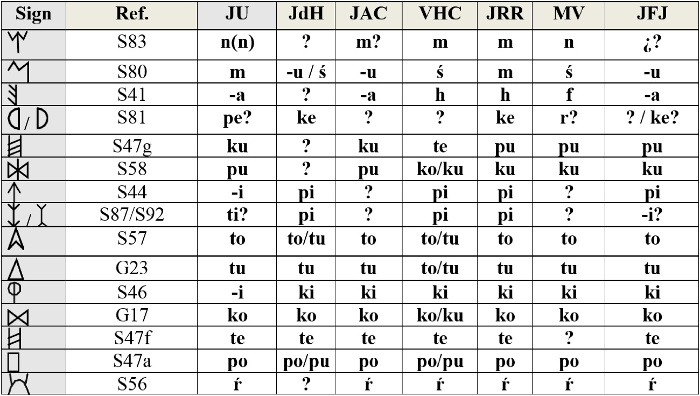
Figure 10: South-Western script signs of disputed value. Source: Ferrer-Moncunill 2019, p. 98 (Palaeohispanic Languages and Epigraphies). Abreviaturas: JU - Jürgen Untermann, JdH - Javier de Hoz, JAC - José Antonio Correa, VHC – Virgílio Hipólito Correia, JRR - Jesús Rodríguez Ramos, MV - Miguel Valério, JFJ - Joan Ferrer i Jané.
Graeco-Iberian Script

Figure 11: Graeco-Iberian script. Writing direction: left-to-right. Source: Adapted from Ferrer-Moncunill 2019, p. 81 (Palaeohispanic Languages and Epigraphies).
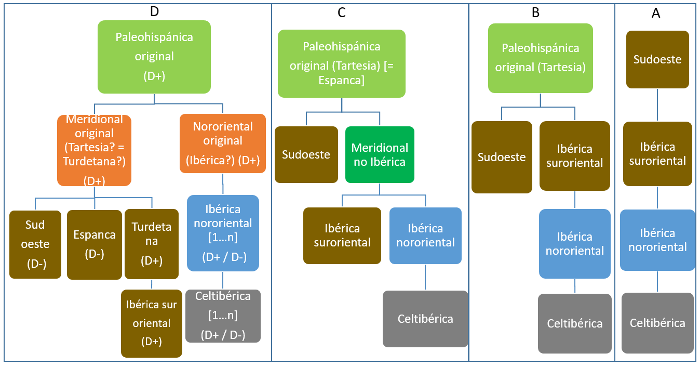
Figure 12: Genealogy models of the Palaeohispanic scripts: (A) J. Rodríguez-Ramos, (B) J. A. Correa, (C) J. de Hoz, (D) J. Ferrer i Jané. Font: Ferrer - Moncunill 2019, pág. 107 (Palaeohispanic Languages and Epigraphies).
© 2005 Departamento de Filología Griega y Lingüística Indoeuropea · Universidad Complutense de Madrid
License Data Bank last update: 2025-12-14 12:33:41